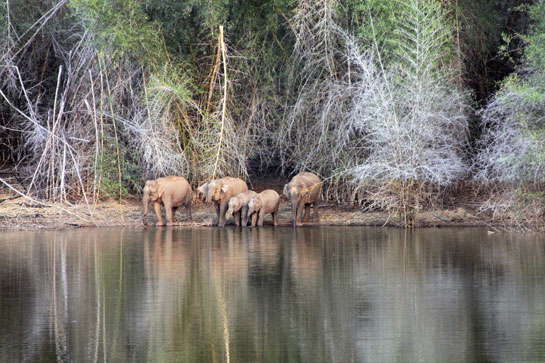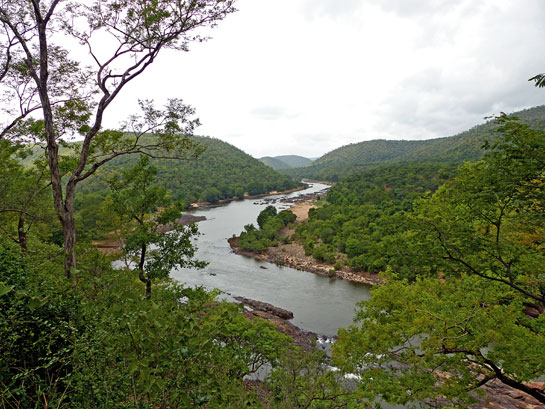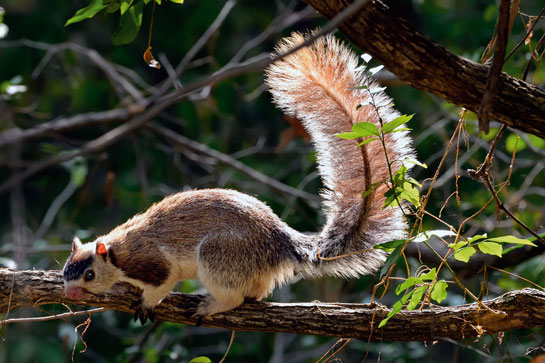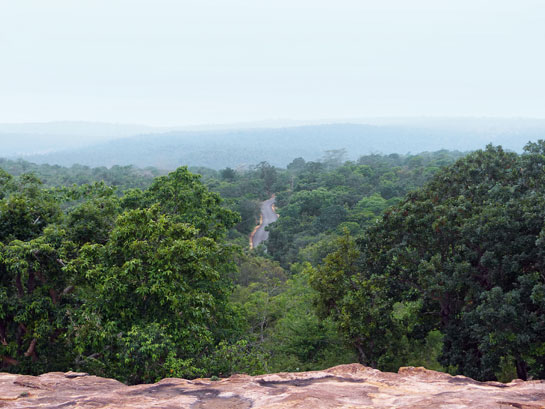Melagiris - Secret Jewel Of The Eastern Ghats
First published in Sanctuary Asia,
Vol. 36
No. 9,
September 2016
By N. Lakshminarayanan
Perched atop a boulder, I scanned the forest trying to locate the elephants that the experienced forest watcher Krishnamurthy had spotted. Soon a large cow elephant emerged from the thick bamboo Dendrocalamus strictus outcrop to slake her thirst in the poor flow of the Doddahalla river. Minutes later, eight more elephants, including three calves, joined the female and drank contentedly on that very hot summer day in May 2015.
Soon after, the herd retired under the vast boughs of a Ficus tree to escape the sun. The Doddahalla river and its gallery forest is a critical source of water for wildlife, and the stately Terminalia arjuna and Mangifera indica that flank its banks offer life-giving shade to elephants and other large animals each summer.

Photo: Aravind Raj.
Around noon we walked back to our vehicle parked on the highway leading to Anchetty town. Kenneth Anderson had often written about this beautiful watercourse, which he referred to as the secret river in his gripping tales. Doddahalla and a myriad other streams originating in the beautiful Melagiris mountain range of the Eastern Ghats feed the great Cauvery river that drains much of south India.
A large section of the range falls in Tamil Nadu's Hosur Forest Division. These jungles run contiguous to other forested tracts in the Eastern Ghats, including Protected Areas such as the Cauvery Wildlife Sanctuary, Bannerghatta National Park, Male Madeshwara Wildlife Sanctuary, Biligiri Rangaswamy Temple Tiger Reserve in Karnataka, and the Sathyamangalam Tiger Reserve in Tamil Nadu.
A vast swathe of multiple-use reserved forests in Tamil Nadu administered by the Dharmapuri and Erode Forest Divisions also run contiguous to this forested belt, which extends from Hosur and Bannerghatta in the east all the way to the Moyar valley to the west, where it meets the Western Ghats. It is one of the largest continuous forest blocks in India, with huge potential for tiger and elephant conservation. As has been pointed out down the decades, protecting forests in the name of such megafauna ends up benefiting a diversity of smaller life forms. In the Eastern Ghats, this includes the grizzled giant squirrel, chousingha or four-horned antelope and ratel, among many other species.

Photo: N. Lakhsminarayanan.
Road to Resurrection
Despite the hilly and rugged terrain, large and small settlements alike have found sustenance through marginal cultivation that ended up perforating critical habitats best suited to support large wild animals. The process of bringing such verdant river valleys, undulating slopes and fertile grasslands under the plough also bequeathed both humans and wildlife with conflicts that do neither any good. The only areas left relatively untouched and available without disturbance to wild species today are inaccessible portions of the rugged hills and steep slopes considered unfit for cultivation. But tragically, of late, powerful politicians have made inroads into this ecologically fragile area in search of profit from the seemingly insatiable demand for granite and black stones from rapidly growing urban settlements. Taking advantage of the tiniest of loopholes in the law (often breaking laws), hilltops located just outside the reserved forests have been plundered by quarries.
Such quarries do not merely destroy forests and wildlife, but also make explosives and weaponry available to poachers who predictably use this to decimate the already beleaguered wildlife. As if this were not enough, roads and other linear intrusions created to facilitate such plunder ended up further fragmenting the troubled forests that are currently wilting under the joint assault by acute cattle grazing, forest fires and unsustainable biomass removal in the Melagiris.
Until a decade ago, the infamous forest brigand Veerappan had triggered administration responses that saw a permanent medley of paramilitary and police forces as a result of which most wild animals were in retreat. When the Veerappan saga ended, the region saw a phased withdrawal of the armed forces and slowly the biodiversity of the Eastern Ghats began to return.
In a move welcomed by all, the state Forest Departments of Karnataka and Tamil Nadu notified sanctuaries and tiger reserves such as Sathyamangalam and Biligirirangan Hills, where tigers and other wildlife have staged a remarkable recovery.As far as the Hosur forests in the Melagiris are concerned, a step in the right direction began with the notification of about 500 sq. km. of the northern range as the North Cauvery Wildlife Sanctuary in 2014. The Kenneth Anderson Naturalist Society (KANS) played a pivotal role by complementing the efforts of the Forest Department.
In neighbouring Karnataka, the extension of the Cauvery Wildlife Sanctuary (south of Hosur) and connecting reserved forests parcels near Kanakpura with the Bannerghatta National Park (west of Hosur) had already helped enliven the landscape. I was delighted with what I saw when I visited the Cauvery Wildlife Sanctuary, where government and non-government agencies are working in sync.
Unfortunately, despite surveys having been conducted, no recent reports of tigers have emerged from the north bank of the Cauvery, though tigers swimming across the river cannot be discounted. Hopefully such wandering tigers will find a niche somehow, but this will only happen if we take purposeful steps to reduce biotic pressures, allowing prey species to recover.

Photo: Bijulal Biju.
The Extra Mile
As it is a new Protected Area, we are still far from attaining our targets in terms of wildlife management, protection protocols, and people-park relationship strategies. Though the North Cauvery Wildlife Sanctuary has been notified, it remains a mere fraction of the overall Melagiris landscape, which harbours some of the finest biodiverse areas imaginable, all of which desperately need to be connected physically and by way of uniform management practices.
As articulated by the founders of Project Tiger in the 1970s, the very first priority must be the natural regeneration of the habitat, a prerequisite for the return of the wild pigs, chital, sambar, gaur, four-horned antelopes, barking deers and monkeys upon which predators are dependent for their survival. If we achieve this, the return of large predators is a given.
In consultation with local communities, the defragmentation of the habitat can be reduced through voluntary relocation initiatives that have proved successful in Bhadra and Rajaji. Particularly those living in remote and isolated villages are petitioning the government for such relocations. This would also greatly reduce incidents of human-animal conflict in Hosur, particularly where elephants are concerned.
As the day drew to a close, I walked back with section forester Selvaraj and beat guard Narayanan along a well-beaten track in the verdant Panai Reserved Forests. In the fading light, we saw the dark forms of three gaurs bolting across the track ahead of us, a wobbly newborn calf in tow. For all the trauma inflicted on wild habitats and species, I marvelled at the capacity of nature to repair itself and knew that with real effort and persistence, the wildlife of this magical Melagiris landscape would recover fast to the advantage of both our biodiversity and human generations yet unborn.

Photo: N. Laksminarayanan.





